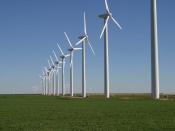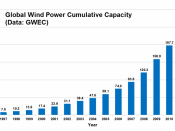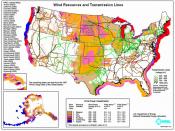Wind Power
Introduction
The contribution from onshore and offshore wind power could in principle be built up to meet at least 10% of the UK's demand for electrical energy by the year 2015. This paper gives a brief discussion on the possibilities of achieving this goal.
Executive Summary
It will be possible to achieve the target of 10% of electricity demand from wind power with environmental and social economic benefits and a source sustainable energy. However there needs to be a better perception within the community regarding wind power, this can be done by increasing peoples awareness so as to dispel any misunderstandings associated with wind power, which should result in planning permission requests being dealt with more efficiently, thus speeding the installation process.
Wind Power
Wind power is the most advanced and commercially available of all the renewable energy resources, and the UK has 40% of the total realizable wind energy within the EU.
To date the UK has not taken maximum advantage of this resource for various reasons, the main reason being that the UK has considerable wealth of fossil fuels.
The advantages that wind power has over fossil fuels are that there are no CO2 emissions, no acid rain, no smog, and no radioactive pollutants associated with this power and wind power conserves our natural non-renewable resources.
Future Electricity Demand
With reference to DTI report1 that shows "Estimated Sales by Licensed Suppliers in GB" up until 2010/2011 and extrapolating this information out to the year 2015 (figure 1) the estimated sales for the year 2015 is 326 TWh. Therefore to meet 10% of this demand wind power would be required to meet a demand of approximately 33 TWh per year.
In 1992, the Renewable Energy Advisory Group (REAG) produced a report on renewable energy for the...


